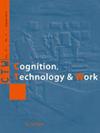Anthropometric data of an elderly Iranian population provides insights for system design.
IF 3.4
3区 工程技术
Q2 ENGINEERING, INDUSTRIAL
引用次数: 1
Abstract
BACKGROUND Anthropometric data should be considered for each major population age category, specifically because of the dimension changes occurring during ageing. In elderly subjects, the physical activities and their capabilities become limited. Therefore anthropometric reference data for equipment and system designs is necessary. OBJECTIVES The aim of the study was to collect data for the body dimensions of an elderly Iranian population and evaluate the related gender and age correlations. METHODS Nineteen body dimensions were manually measured on a sample size of 317 subjects (167 male and 150 female) from four provinces of Iran. A pilot preliminary test for assessing test-retest reliability on ten body dimensions using the Intraclass Correlation Coefficient (ICC2 :1) was performed. Descriptive statistics were reported based on gender and independent samples t-tests to compare the anthropometric dimensions of both genders and age. RESULTS Results indicated higher dimensions in males, except for hip-breadth (p = 0.87). In all subjects, increasing age corresponded with: decreased standing shoulder height, eye height, and elbow height; and with sitting height and sitting knee height; while hip-breadth increased. Reliability was acceptable (ICC2.1 >0.88). In the elderly, as with adult subjects, there are significant gender differences in body dimensions, and this should be considered in equipment and system designs. Furthermore, this study demonstrated both genders differences and the consequences of aging. CONCLUSIONS From this pilot data, product designers can consider the anthropometric characteristics for elderly Iranian subjects for equipment and system designs.伊朗老年人口的人体测量数据为系统设计提供了见解。
背景:人体测量数据应该考虑到每个主要的人口年龄类别,特别是因为在老龄化过程中发生的尺寸变化。在老年受试者中,身体活动和他们的能力变得有限。因此,人体测量学的参考数据对设备和系统的设计是必要的。目的:本研究的目的是收集伊朗老年人的身体尺寸数据,并评估相关的性别和年龄相关性。方法对来自伊朗4个省的317名受试者(167名男性,150名女性)进行19项身体尺寸手工测量。使用类内相关系数(ICC2:1)进行了评估10个身体尺寸的重测信度的试点初步测试。描述性统计报告基于性别和独立样本t检验来比较性别和年龄的人体测量维度。结果除臀宽外,男性各维度均较高(p = 0.87)。在所有研究对象中,年龄的增加与站立时肩高、眼高和肘部高度的降低相对应;并与坐高和坐膝高度有关;而臀部宽度增加。可靠性可接受(ICC2.1 >0.88)。在老年人中,与成人受试者一样,在身体尺寸上存在显著的性别差异,在设备和系统设计中应考虑到这一点。此外,这项研究还证明了性别差异和衰老的后果。结论从这些试验数据中,产品设计师可以在设备和系统设计中考虑伊朗老年人的人体测量特征。
本文章由计算机程序翻译,如有差异,请以英文原文为准。
求助全文
约1分钟内获得全文
求助全文
来源期刊

Cognition Technology & Work
ENGINEERING, INDUSTRIAL-
CiteScore
6.90
自引率
7.70%
发文量
26
审稿时长
>12 weeks
期刊介绍:
Cognition, Technology & Work focuses on the practical issues of human interaction with technology within the context of work and, in particular, how human cognition affects, and is affected by, work and working conditions.
The aim is to publish research that normally resides on the borderline between people, technology, and organisations. Including how people use information technology, how experience and expertise develop through work, and how incidents and accidents are due to the interaction between individual, technical and organisational factors.
The target is thus the study of people at work from a cognitive systems engineering and socio-technical systems perspective.
The most relevant working contexts of interest to CTW are those where the impact of modern technologies on people at work is particularly important for the users involved as well as for the effects on the environment and plants. Modern society has come to depend on the safe and efficient functioning of a multitude of technological systems as diverse as industrial production, transportation, communication, supply of energy, information and materials, health and finance.
 求助内容:
求助内容: 应助结果提醒方式:
应助结果提醒方式:


